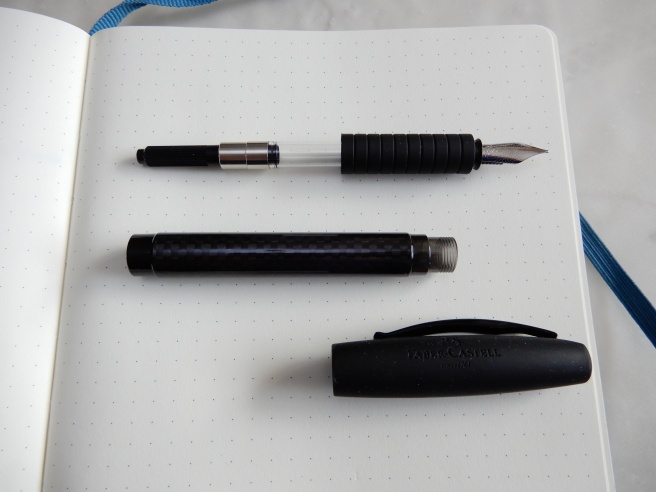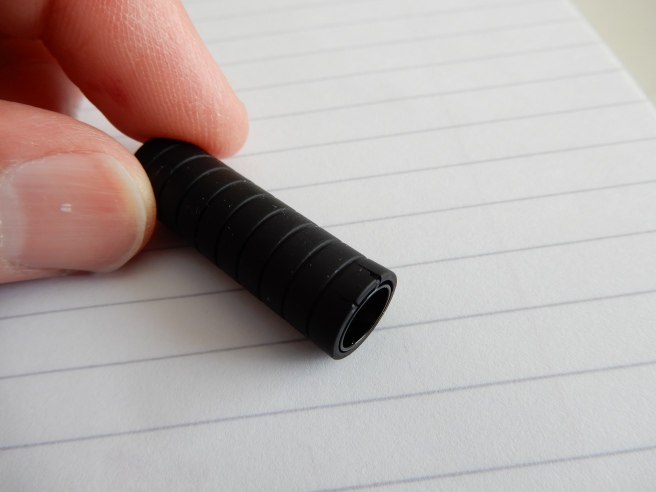Whilst at Victoria Station recently, with ten minutes to spare before my train was due to leave, I popped in to WH Smiths to have a browse around their stationery section. There I made the happy discovery that they sell Faber-Castell fountain pens.
I bought a Faber-Castell Loom earlier this year and have been using it as my every day carry. It is my most successful of the Faber-Castells that I have tried. I found the Emotion too short for me and too heavy; the Ambition (black resin version) also too short and too slippery, or too back-heavy if posted. However, their steel nibs had all been excellent. Even on their £5.00 plastic school pens, the nibs were very enjoyable.
I spotted a pen which looked similar to my Loom, but with a slightly different shaped cap and which had a shiny, black carbon-fibre look to the barrel. Also, the long, cylindrical section was of grippy black rubber. There was even a smoky grey ink window. I now know this to be the Faber-Castell Basic, black carbon version.

I asked to have a look at it and was immediately impressed by the length of the pen when uncapped, (about 134mm) which was considerably longer than my Loom, which I took out of my pocket, to compare. The familiar stainless steel nib looked in good shape and I decided to buy it. The sales assistant apologised that it did not have a cartridge with it but that did not bother me. A new Faber-Castell, like my Loom but longer! What could possibly go wrong?
Later inspecting my purchase, I unscrewed the barrel and found a spent blue cartridge inserted in the pen. Either someone had been testing the pen rather too extensively in the store, or it had had a previous owner and was a return. Never mind, the nib looked promising and I was not bothered about having to clean it first.
At home that evening, I flushed the pen. I planned to fill it with Graf von Faber-Castell Garnet Red. It is important to remove all traces of blue ink from the nib and feed first, otherwise you lose that lovely deep orangey-red colour in the Garnet, and instead it turns to a burgundy. (Ask me how I know this).
So after flushing the section several times I unscrewed the nib and feed unit from the section and patiently left it to soak in a jar of water overnight.

The next day, when screwing the nib unit back into the grip, (having carefully flushed it again, dried it and applied a little silicone grease on the threads) I realised that I had forgotten what it was supposed to look like. Or rather, I did not realise that I had forgotten and went on screwing it in, expecting to get the unit to fit flush into the grip, right up to the start of the nib, like the Loom. (DO NOT DO THIS!) Needless to say, it did not want to go in any further.
Next I got out a standard international converter. None was supplied with the pen, but I had a few different brands. The first I tried, did not grip onto the coupling at all. The next one, (actually a screw-fit converter, from a Conklin Duragraph) gripped nicely so I gleefully filled it with my Garnet Red ink.

Next, on trying to replace the barrel, I found that it was a very tight fit over the converter, although it did just fit, so I screwed the barrel into place. (DO NOT DO THIS EITHER!) I then tried unscrewing the barrel again and was alarmed to find that, in unscrewing the barrel, the metal collar of the converter had unscrewed and was now firmly wedged inside the barrel.
The only way to retrieve this was to offer the converter back into the barrel (losing the ink first), screw it back into its collar, and pull. This operation, thankfully, was a success. I also learned how to disassemble, clean and re-grease a Conklin Duragraph converter in the process.
I found a different converter to use, this time checking not only that it would grip on the coupling, but also that the barrel would fit over it without touching the sides, before filling. I inserted a Kaweco converter (not the mini one but from a Dia 2) which worked fine.
So I filled the pen, replaced the barrel and thought that all would be well. However, the next discovery was that the cap had become an uncomfortably snug fit, when capping and uncapping the pen. Closer inspection revealed the apparent cause of this to be that the rubber grip had several stress cracks at the nib end and the rubber had actually flared out very slightly and was rubbing on the inside of the cap. This probably happened when I had been trying to screw the nib unit too deeply into the grip.

Conclusion.
I think the Basic will be great pen, once I have obtained a replacement rubber grip. However it is not fool proof. I have since enjoyed watching old reviews of the pen by Stephen Brown and Brian Goulet who both spoke very highly of it. As a veteran of over 200 pen purchases, I had become sloppy and made a series of mistakes. Did you spot them all?
Notes to self:-
- Do not rush a fountain pen purchase, if you have a train to catch;
- Inspect the pen properly before purchase, including under the barrel;
- Before removing a nib, perhaps take a photo as a record of how it looked before;
- Do not use force when screwing a nib and feed back into a section;
- Before filling a converter, (if it did not come with the pen) check that the barrel will fit over it.
- If the barrel is going to be a tight fit over the converter, use a converter that fits properly.
- You are only as good as your last pen purchase.
I hope that Faber-Castell will not mind sending me a replacement rubber grip and I can then start to use and enjoy the pen, with a fresh start.

Yesterday I knocked over my pen cup and all the expensive ones crashed to the floor. 🤦🏻♀️ Could’ve been 😱
LikeLiked by 1 person
Oh no! That is a heart-stopping moment. I do hope there were not many casualties. The Dialog 3 may have damaged your flooring☺
LikeLiked by 1 person
Miraculously all the pens were okay. 😊 And I suppose the floor indeed was lucky there was no D3 in the cup.😊 But these sorts of things happen to all of us.
LikeLiked by 1 person
Look on the bright side… at least it was a cheap pen! 🙂 And you certainly won’t make any of those mistakes again…
LikeLiked by 2 people
Yes, right on both points, I hope. ☺
LikeLike
Lots of great lessons to be learned here.
LikeLiked by 1 person
Thankyou. Happily all was well in the end. I returned the pen to Faber-Castell’s UK service centre and they kindly sent me a new one.
LikeLike
I found this thread since I too have an Essentio. In fact it’s my 2nd one.
The first I bought in April 2018, and after 2 cartridge changes I too noticed the stress fractures in the nib housing. Thought it was a design fault so I got in touch with the seller who directed me to Faber’s Customer Care.
They were great and sent an entirely new pen for me to try. This was super of them yes, and I was VERY careful not to over tighten the nib/cartridge housing.
I’ve not used this pen for a while and picked it up today, took the snap cap off and guess what, the screwed in nib/cart housing came right off with it?! Strange! I finally managed to get the top off without removing the housing and to my surprise there was a huge stress crack in grip area. It had also flayed out, now this pen has been upright and capped for a few weeks, it can get warm in my office but that crack was NOT there last time I used it and no one else uses these pens, only me.
I think the grip on these pens is susceptible to cracking as this is the 2nd one I’ve had do it. I also now think that the grip swells/shrinks depending on temperature and also maybe weakens if it’s gotten wet (which it will get to some degree with flushing).
The pen is awesome for the price but I think the materials need some more thought. I have cheaper, plastic pens that have outlasted this one!
So it may not be a heavy hand that cracked the grip, it might always have happened!
LikeLiked by 1 person
Hi Kelly, Thank you for getting in touch and for your interesting comments about your own experiences with this model.
I have just checked mine again: all looks well! I will take care not to overtighten anything and will keep an eye out for any cracking.
The nib is super smooth. I also have a Loom in the shiny gun metal finish with a similarly good nib. I like to use them with Graf von Faber Castell Cobalt blue cartridges.
LikeLike